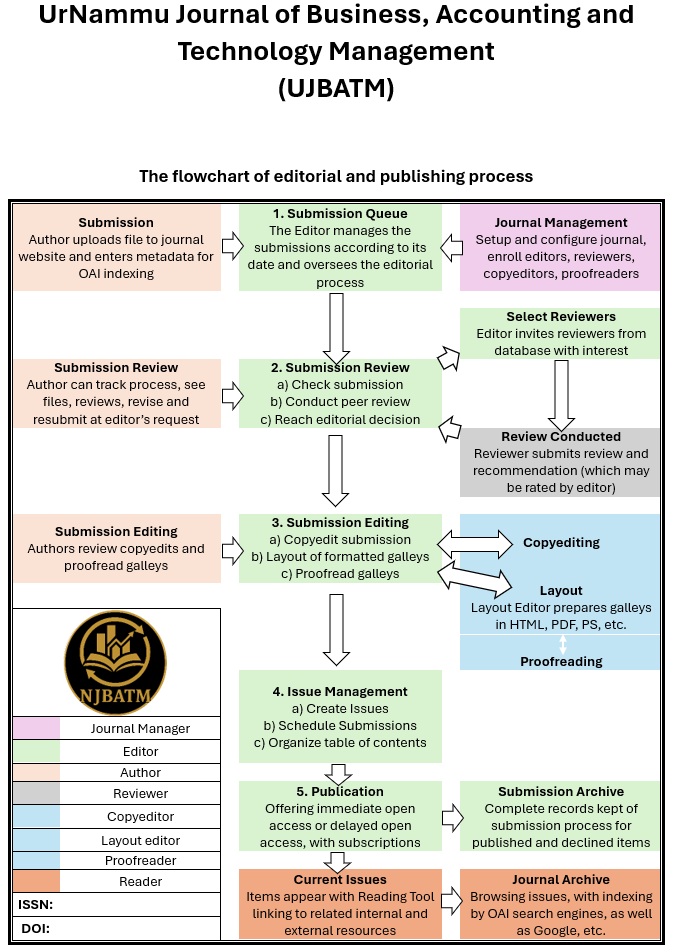Peer Review Process
The UrNammu Journal of Business, Accounting and Technology Management (UJBATM) follows a double-blind peer review process to ensure the integrity and quality of manuscript evaluations. All submissions must be made through the journal’s online manuscript submission system. Manuscripts that meet the journal’s basic requirements and fall within its aims and scope are forwarded by the Editor-in-Chief to three independent reviewers. These reviewers are external experts, unaffiliated with the authors’ institutions and not members of the UJBATM editorial board. Prior to the review, all manuscripts undergo a similarity check using Turnitin. Corresponding authors will be notified of the editorial decision—acceptance or rejection—via the online system within one to two months. The UJBATM relies exclusively on reviewers who have specialized academic reputation and encourages authors to recommend potential reviewers in their submissions' topics. While editorial board members do not act as reviewers, they play a crucial role in selecting appropriate reviewers based on their subject expertise and academic standing.

Peer Review Process – UJBATM Flowchart
1. Submission of Article
The author uploads the manuscript to the UJBATM online submission system and enters the required metadata for OAI indexing, initiating the submission process.
2. Structural Assessment
Under “1. Submission Queue”, the Editor checks that the submission is complete and follows journal formatting and sectioning guidelines. This includes a preliminary administrative and structural assessment but not content quality.
3. Editor-in-Chief Assessment and Processing
The Editor-in-Chief or assigned Section Editor evaluates whether the article fits the aims and scope of UJBATM and assesses its originality and relevance. Articles not meeting basic criteria are rejected without external review.
4. Plagiarism Checkup
Before being sent to reviewers, the article is passed through plagiarism detection software (Turnitin). Only submissions with similarity scores below the journal's threshold (commonly <20%) proceed to review.
5. Invitation to Reviewers
Under “Select Reviewers”, the editor sends out review invitations to scholars whose expertise matches the manuscript. Reviewers are selected from an internal and external database.
6. Response to Invitations
Potential reviewers evaluate the invitation based on their expertise and availability. Upon accepting, they proceed with the peer review task; otherwise, alternate reviewers are contacted.
7. Review is Conducted
As seen in the “Review Conducted” stage:
Reviewers evaluate the manuscript in depth, often reading it several times. They submit a structured review form along with a recommendation:
• Accept
• Minor revision
• Major revision
• Reject
The Editor may also rate the review quality.
8. Journal Evaluates the Reviews
In the “2. Submission Review” step:
The Section Editor or Editor-in-Chief assesses all reviewer reports, possibly consulting a third reviewer if there’s significant disagreement.
9. Primarily Decision
After evaluating reviews, the Editor sends the editorial decision to the corresponding author via the system. The decision includes anonymous reviewer feedback, and can be:
• Accept
• Revise (Major/Minor)
• Reject
10. Author Sends Revised Manuscript
As indicated in “Submission Review”, authors revise the manuscript according to reviewer feedback, clearly highlighting changes (commonly using red font or yellow highlights), and then resubmit via the system.
11. Final Decision
Once resubmitted, the Editor assesses the revised version. If satisfactory, the manuscript proceeds to:
• Copyediting
• Layout formatting
• Proofreading
Finally, the author pays the Article Processing Charge (APC), and the manuscript moves toward issue scheduling and publication.








